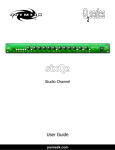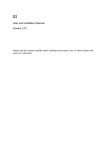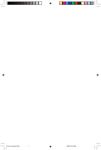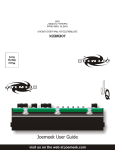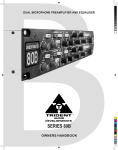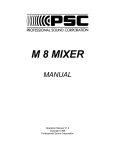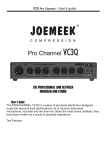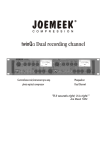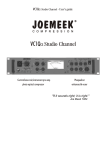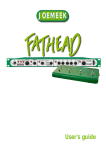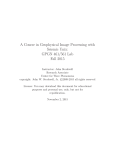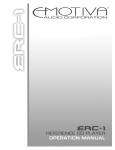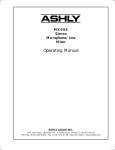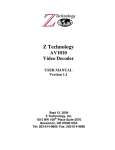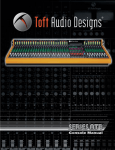Download the twinQ2 manual
Transcript
2 TM 150 200 PAD 50 40 LINE twin 0 -3 Hz 3k +9 dB LF FREQ +12 +15 0 -3 2k 1k +6 -12 -15 650 1k5 +3 -6 400 -9 85 +3 -6 -3 +6 -9 0 +3 -6 +9 -9 4k 300 5k Hz -15 +15 dB -15 MID 2 35(0) 40 PEAK 25 45 20 INSTR dB 0 48V 150 dB +15 0 -4 3:1 -10 +4 VU dB PAD +10 40 LINE M E E K GAIN 10 +10 +8 1 50 +5 +12 GAIN -20 +3 COMPRESS HPF 1:1 10:1 SLOPE 1 ms 100 ATTACK 0.1 sec dB LF FREQ 1 GR +12 +15 3 RELEASE +3 -6 -3 +6 -9 +16 0 dB 30 COMP +9 300 INSTR PRE GR 40 PEAK 45 CLK LINK dB -20 -10 +4 -7 -5 -3 -15 MID FREQ 0 -4 +15 dB -15 MID 3:1 -10 +4 dB -oo +15 dB +3 DUAL STUDIO CHANNEL +10 M E E K GAIN HF (12kHz) ON 10 J O E M E E K 0.3 +8 5:1 2:1 5 +10 0 VU -30 5k Hz PEAK FSD 0 -20 +9 1 50 -15 +5 +12 +3 2 GR +16 METER 2 50 18 EXT ON -9 -6 -10 -15 +6 OPTICAL COMPRESSOR 35(0) 20 +20 MAKE UP GAIN +3 4k LF 25 METER 0 -6 6kHz / O 2 dBu -12 -15 650 3k +9 0 -3 2k 1k +6 PREAMP -15 +oo 60 Hz 1k5 +3 IRON 0.3 5 0 -3 -6 400 -9 85 ON 5:1 2:1 200 +3 50 HF (12kHz) 50 18 -7 -5 -3 OPTICAL COMPRESSOR PREAMP 30 +4 -oo 6kHz IRON / O -20 -10 -30 MID FREQ LF 0 -20 +9 OUTPUT MEEQUALIZER PEAK FSD -6 -10 -15 +6 +oo 60 GAIN dBu -20 1:1 COMPRESS SLOPE HPF twinQ2 Dual Studio Channel User Guide joemeek.com 10:1 1 ms 100 ATTACK 0.1 sec 3 RELEASE 0 dB +20 MAKE UP GAIN O OUTPUT MEEQUALIZER 48V ON PRE GR TM Designed in England and assembled in China to strict Joemeek specifications, Joemeek is manufactured under the direction of and distributed exclusively by: PMI AUDIO GROUP USA: 1845 W. 169th Street Gardena, CA 90247 toll free: 877-563-6335 fax: 310-323-0900 UK: Unit 4 Minerva Court Woodland Industrial Estate Torquay, TQ2 7BD tel: +44 (0)1803-612700 fax: +44 (0)1803-612009 email: [email protected] www.joemeek.com Written by Allan Bradford, MSc JOEMEEK ® is a registered trademark of PMI Audio Group Important Safety Instructions Important Safety Information 1. Read these instructions. 2. Keep these instructions. 3. Heed all warnings. 4. Follow all instructions. 5. Do not use this apparatus near water. Do not expose to drips or splashes. Do not place any objects filled with liquids, such as vases, on the apparatus. 6. Clean only with dry cloth. 7. Do not block any ventilation openings. Do not install this apparatus in a confined space such as a book case or similar unit. Install only in racks designed for the purpose and in accordance with manufacturers’ instructions. 8. Do not install near any heat sources such as radiators, heat registers, stoves, or other apparatus (including amplifiers) that produce heat. 9. Do not defeat the safety purpose of the polarized or grounding-type plug. A polarized plug has two blades with one wider than the other. A grounding-type plug has two blades and a third grounding prong. The wide blade or the third prong are provided for your safety. If the provided plug does not fit into your outlet, consult an electrician for replacement of the obsolete outlet. 10. Protect the power cord from being walked on or pinched particularly at plugs, convenience receptacles, and the point where they exit from the apparatus. 11. Only use attachments and accessories specified by the manufacturer. CAUTION CAUTION: TO REDUCE THE RISK OF ELECTRIC SHOCK, DO NOT REMOVE COVER. NO USER-SERVICEABLE PARTS INSIDE. REFER SERVICING TO QUALIFIED SERVICE PERSONNEL. The lightning flash with arrowhead symbol, within an equilateral triangle, is intended to alert the user to the presence of uninsulated “dangerous voltage” within the product’s enclosure that may be of sufficient magnitude to constitute a risk of electric shock to persons. The exclamation point within an equilateral triangle is intended to alert the user to the presence of important operating and maintenance (servicing) instructions in the literature accompanying the appliance. WARNING: TO AVOID FIRE OR ELECTRIC SHOCK HAZARD, DO NOT EXPOSE THIS APPARATUS TO WATER, RAIN OR MOISTURE. NOTE — This apparatus does not exceed the Class A/Class B (whichever is applicable) limits for radio noise emissions from digital apparatus as set out in the radio interference regulations of the Canadian Department of Communications. . ATTENTION — Le présent appareil numérique n’émet pas de bruits radioélectriques dépassant las limites applicables aux appareils numériques de class A/de class B (selon le cas) prescrites dans le réglement sur le brouillage radioélectrique édicté par les ministere des communications du Canada. These limits are designed to provide reasonable protection against harmful interference in a commercial/residential installation respectively. This equipment generates, uses, and can radiate radio frequency energy and, if not installed and used in accordance with the instruction manual, may cause harmful interference to radio communications. There is no guarantee that interference will not occur in a particular installation. If this equipment does cause interference to radio or television equipment reception, which can be determined by turning the equipment off and on, the user is encouraged to try to correct the interference by any combination of the following measures: (1) Relocate or reorient the receiving antenna (2) Increase the separation between the equipment and the receiver (3) Plug the equipment into an outlet on a circuit different from that to which the receiver is connected (4) Consult your dealer or experienced radio/television technician for additional assistance. 12. Use only with a cart, stand, tripod, bracket, or table specified by the manufacturer, or sold with the apparatus. When a cart is used, use caution when moving the cart/apparatus combination to avoid injury from tip-over. 13. Unplug this apparatus during lightning storms or when unused for long periods of time. 14. Refer all servicing to qualified service personnel. Servicing is required when the apparatus has been damaged in any way, such as power-supply cord or plug is damaged, liquid has been spilled or objects have fallen into the apparatus, the apparatus has been exposed to rain or moisture, does not operate normally, or has been dropped. 15. Apparatus designed with Class-I construction must be connected to a mains socket outlet with a protective earthing connection (the third grounding prong). 16. This apparatus may be equipped with a single-pole, rocker-style AC mains power switch. If so this switch is located on the front panel and should remain readily accessible to the user. 17. The manufacturer reserves the right to change the technical specification of the product without prior notice. CAUTION — Changes or modifications to this equipment not expressly approved by the party responsible for compliance could void the user's authority to operate this equipment. 3 Statement of RoHS Compliance Statement of WEEE Policy PMI Audio Group manufactures complete electronic products which are covered by the European Union’s “Removal of Hazardous Substances” directive 2002/95/EC (RoHS). This directive seeks to eliminate toxic substances from the manufacturing process, such that when equipment is disposed of at the end of its life cycle, the materials it contains do not contaminate the environment and pose health risks. Banned substances are lead, mercury, cadmium, hexavalent chromium, polybrominated biphenyls (PBB) and poly-brominated diphenyl ethers (PBDE). Lead is used together with tin in solder connections to reduce the melting point of solder. Lead-free solder requires higher soldering temperatures which in turn places greater thermal stress on components. PMI Audio Group manufactures many complete electronic products which are covered by the European Union’s “Waste Electric and Electronic Equipment” directive 2002/96/EC (WEEE). This directive seeks to ensure that waste electric and electronic equipment is disposed of in an environmentally responsible manner, at the end of its life cycle. PMI Audio Group takes seriously its obligations under this directive to take back WEEEaffected products and, from 13th August 2005, will mark all such products with the crossed-out wheeled bin symbol. RoHS COMPLIANT Business to Business products: PMI Audio Group will cost-neutrally take back WEEE-affected electric and electronic equipment in this category, from 1st January 2006. PMI Audio Group will work with disposal and recycling partners working within the EU. The waste electric and electronic equipment can then be turned over to a disposal and recycling companies in the countries concerned. Business to Customer products: emerging electric and electronic equipment will be disposed of by local authorities' collection systems. Dual Use products: this equipment will be disposed of by local authorities' collection systems. Pb PMI Audio Group takes seriously its obligations under the RoHS directive and insists that its factories use only components that are certified RoHS compliant, as well as lead-free solder. In a very few cases the necessary components may not yet be available to the world market but we work continuously to eliminate any such exceptions at the earliest opportunity. Our printed Circuit Boards (PCB’s) and all soldered joints have been leadfree since 2005. 4 Contents JOEMEEK: the Legend Continues Controls at a Glance..........................................6 & 7 Joemeek studio processors represent a quantum leap in the history of the Joemeek legend. Long regarded for its "Big Sound", the original Joemeek gear was both revered and reviled for its somewhat "quirky" nature. So we took the best of what made the old Joemeek products sound great, refined it, distilled it, added to it and repackaged it. Overview..............................................................5 Preamplifier.........................................................8 Insert Point..............................................................9 Meter......................................................................9 Compressor............................................................9 Meequalizer............................................................11 Output Stage..........................................................12 Digital Interface.......................................................12 Properly and robustly engineered for predictable, controllable performance, the latest generation retains the famous Joemeek sound, with its wide, flat frequency response extending from subsonic to ultrasonic. It also uses genuinely low noise circuitry, with lots of headroom (immunity to overload). Accurate calibration and metering, together with clear panel labeling, give you complete confidence in what's going on. Joemeek products are founded on good solid electronic and audio engineering, and withstand direct comparison with the very best names in mixers and outboard gear. Using the twinQ2...................................................13 Getting Connected..................................................13 Using the Preamp...................................................13 Using the Compressor.............................................13 Using the Meequalizer.............................................13 Using the Output Stage...........................................14 The Joemeek range provides everything you need to get your performance into your recording device. Now the latest JOEMEEK Q2 series features an entirely new world-class Preamp using a top-quality Cinemag microphone transformer. In addition, low noise Burr Brown OPA2134 audio amplifiers are used throughout the signal path, headroom is increased and power consumption is reduced. Troubleshooting...................................................14 Technical Specification........................................15 Overview About the Designer The JOEMEEK twinQ2 is like having one channel of a professional recording studio in one box. It takes microphones or instruments, amplifies them, compresses and equalises them ready to be recorded. Simple to use yet extremely powerful, the twinQ2 will bring out the best in any microphone or instrument and give the gloss of a professional studio production to all your performances. It can also be very useful for live work! Since 2003 the Joemeek product range has been designed by renowned audio electronics engineer Allan Bradford. With his background in physics and over 30 years experience with the design of instruments, mixers, processors and amplifiers, Allan's unique range of expertise ensures that Joemeek remains at the forefront of music technology. Think of the twinQ2 as five separate items of equipment: • Preamplifier • JOEMEEK Optical Compressor • Meequalizer EQ • Fader • A to D Converter ... twice! 5 Controls at a Glance 150 200 85 PAD 50 40 LINE twin 0 -3 Hz 3k +9 dB LF FREQ +12 +15 0 -3 2k 1k +6 -12 -15 650 1k5 +3 -6 400 -9 +3 -6 0 -3 +6 -9 +3 -6 +9 -9 4k 300 5k Hz -15 +15 dB -15 MID 2 35(0) 40 PEAK 25 45 20 dB INSTR dB 0 48V 150 0 -4 3:1 -10 +4 VU dB PAD +10 40 LINE M E E K GAIN 10 +10 +8 1 50 +5 +12 GAIN -20 +3 COMPRESS 1:1 10:1 SLOPE 1 ms 100 ATTACK 0.1 sec 3 RELEASE HPF dB LF FREQ 1 GR +12 +15 +3 -6 -3 +6 -9 +16 0 dB 30 COMP +9 300 INSTR PRE GR 40 PEAK 45 CLK LINK dB -20 -10 +4 -7 -5 -3 0 -15 MID FREQ 0 -4 +15 dB -15 MID 3:1 -10 +4 dB -oo +15 dB DUAL STUDIO CHANNEL +10 M E E K GAIN HF (12kHz) ON 10 J O E M E E K 0.3 +8 5:1 2:1 5 +10 +3 VU -30 5k Hz 0 -20 +9 1 50 -15 +5 +12 +3 2 GR +16 METER 2 50 18 EXT ON -9 PEAK FSD -6 -10 -15 +6 OPTICAL COMPRESSOR 35(0) 20 +20 MAKE UP GAIN +3 4k LF 25 METER 0 -6 6kHz / O 2 dBu -12 -15 650 3k +9 0 -3 2k 1k +6 PREAMP -15 +oo 60 Hz 1k5 +3 IRON 0.3 5 0 -3 -6 400 -9 85 ON 5:1 2:1 200 +3 50 -oo +15 50 18 -7 -5 -3 OPTICAL COMPRESSOR PREAMP 30 +4 HF (12kHz) 6kHz IRON / O -20 -10 -30 MID FREQ LF 0 -20 +9 OUTPUT MEEQUALIZER PEAK FSD -6 -10 -15 +6 +oo 60 GAIN dBu -20 COMPRESS HPF 1:1 10:1 SLOPE 1 ms 100 ATTACK 0.1 sec 3 RELEASE 0 dB +20 MAKE UP GAIN O OUTPUT MEEQUALIZER 48V ON PRE GR 48V PHANTOM POWER switch - feeds 48 volts to the microphone XLR connectors, to power condenser microphones. MAKE UP GAIN - restores the level of the signal after compression. PAD switch - selects 20dB attenuation of the Mic (XLR) inputs. COMP LINK - for stereo work, the master twinQ2's "Compress", "Attack" and "Release" control both master and slave twinQ2 (the corresponding controls on the slave twinQ2 are redundant). This avoids stereo image shifts. All other controls still operate independently on both master and slave and must be set the same for correct stereo balance. LINE switch - selects the Line and INSTRument (1/4" jack) inputs and deselects the Mic (XLR) input. IRON switch - selects transformer coupling of the Line (1/4" jack) inputs. Ø switch - reverses the phase of all inputs. Compressor ON switch - turns the compressor on. MIC input - low impedance microphone input. Parallels the Rear Panel MIC socket. Use only one of these two sockets at a time. LF - controls the volume of Low Frequencies or "Bass" in the audio spectrum. 15dB of boost or cut is available at the selected frequency. INSTRument input - high impedance input. Plugging in here overrides anything plugged into the Line or Mic inputs. LF FREQ - sets the frequency at which the LF control operates, anywhere from 40Hz to 650Hz. PREAMP GAIN - sets the amount of audio amplification. Too little gain and the sound will be too quiet; too much and the signal could become distorted. PEAK LED - lights 6dB below clipping. MID - controls the Higher Middle frequencies in the audio spectrum. 15dB of boost or cut is available at the selected frequency. HPF - "high-pass filter". Mainly for use with microphones, this helps remove stage rumble, handling noise and "pops". MID FREQ - sets the frequency at which the HM control operates, anywhere from 300Hz to 5kHz. METER - analogue movement shows output signal level (VU), preamp signal level, or the amount of Compressor gain reduction (GR) in dB, depending on the settings of the Meter switches. The 'PRE' switch overrides both "VU" and "GR" metering. HF - controls the volume of the High Frequencies or "Treble" in the audio spectrum. 15dB of boost or cut is available at the selected frequency. 6kHz switch - sets the frequency at which the HF control operates: in for 6kHz, out for 12KHz. COMPRESS - sets the level of signal (or "Threshold") above which the signal starts to be compressed. EQ ON switch - turns the Meequalizer on. SLOPE - sets the compression ratio applied to signals above threshold. OUTPUT GAIN - the volume control or "Fader" for the output of the twinQ2. ATTACK - sets how quickly the compressor responds to peaks above threshold. PEAK FSD LED - lights 6dB below clipping. "FSD" means "Full Scale Digital" and this LED also warns you if the Digital Interface is about to be overloaded. RELEASE - sets the time taken for the signal to return to its normal size after compression. In general, the longer the time, the less obvious the compression. 'EXT CLK' LED - illuminates when the twinQ2's digital output is successfully locked to an external word clock 6 Rear Panel at a Glance twinQ 2 DUAL STUDIO CHANNEL CAUTION AC POWER ONLY VOLTAGE: 115/230 V~ FREQUENCY: 50/60 Hz POWER: 30 VA J O E M E E K RISQUE DE CHOC ELECTRIQUE NE PAS OUVRIR CAUTION ENSURE CORRECT RATINGS WHEN REPLACING FUSES. FUSE RATINGS: 230V~ T500mA 115V~ T1A EN55103 EN60065 www.joemeek.com DESIGNED IN THE UK FOR PMI AUDIO MADE IN CHINA ENSURE MAINS VOLTAGE AND FUSE RATINGS ARE CORRECT BEFORE CONNECTING MAINS POWER. THIS APPARATUS MUST BE EARTHED BY THE POWER CORD. NO USER SERVICEABLE PARTS REFER SERVICING TO QUALIFIED PERSONNEL. CHANNEL 2 CHANNEL 1 DIGITAL INTERFACE AES/EBU OUTPUT SPDIF OUTPUT OPTICAL OUTPUT WORD CLOCK IN 48k x2 +4dBu +4dBu 44.1k x1 -10dBV -10dBV SAMPLE FREQUENCY OUTPUT +4dBu OUTPUT DIGITAL INTERFACE - outputs two channel digital audio in S/PDIF format (optical and RCA phono connectors) and AES3 (XLR connector). INSERT LINE INPUT MIC INPUT OUTPUT +4dBu OUTPUT INSERT LINE INPUT MIC INPUT +4dBu/-10dBv switch - selects the operating level of the 1/4" jack output, either to the professional standard of +4dBu, or to -10dBv which may be more suitable for hi-fi amplifiers and some computer sound cards. WORD CLOCK INPUT - BNC connector allows the twinQ2 to be synchronized to an external word clock. Sample Rate switches - select 44.1kHz, 48kHz, 88.2kHz or 96kHz. Channel 2 Analog Input - allows an external balanced analogue audio signal to be fed to (the otherwise unused) digital channel 2. 7 Preamplifier This is the all-important front end to the twinQ2. Its job is to accept any type of microphone, instrument or other source of audio signal, and make it loud enough. Microphones need rather a lot of amplification, while guitars, keyboards and CD players need less. Mics need to be connected to low impedance inputs, while instruments prefer high impedance inputs. To ensure correct impedance matching, the inputs are split into an XLR connector for Mics, and 1/4" jack "Line" and "INSTRument" connectors for everything else. A switch on the front panel decides which input connector is active, the XLRs or the 1/4" jacks. The LED next to the switch lights to show that the Line inputs (jacks) are selected:- Microphone inputs up to +4dBu can be accommodated without distortion (+24dBu by using the 'PAD' switch). The (0) symbol next to the 35dB mark, means unity gain, or 0dB, for a signal in the Line input. For Line inputs the range of gain adjustment either side of this mark, is +22dB, -19dB. For the "INSTRument" input the gain range is 0dB to +40dB. The microphone input transformer is permanently assigned to the "Mic" Input. The 'IRON' switch optionally sends the "Line" input through the transformer, to add some colouration to Line sources. The 'PEAK' LED lights +16dBu, which is 6dB below clipping, so occasional brief flashes are OK but if it's on all the time you need to back off the Input Gain! 'LINE' switch out (LED off) = "Mic" 'LINE' switch in (LED on) = "Line" or "Instr" The Mic input is transformer balanced and the Line input is electronically balanced. Note: although the Line input is not normally used for microphones, it can also be suitable for some high output unbalanced microphones, such as battery powered Electret types. The front and rear panel Mic inputs (XLR) are balanced and wired as follows: 'HPF' means "high-pass filter". Mainly for use with microphones, this helps remove stage rumble, handling noise and "pops". The LED lights when active. Technical stuff Very low noise - does it matter? Yes and no, it all depends what you are doing - what really matters is "signal-to-noise ratio". All electronics produce a certain amount of background noise - it's in the nature of things. Providing there is only a relatively small amount of noise, the signal will cover it up, or "mask" it. So providing the signal is much bigger than the noise, you won't be aware of the noise. In other words the "signal-to-noise ratio" needs to be a big number, ideally such as 80dB or 90dB. Pin 2: + (hot) Pin 3: - (cold) Pin 1: ground The Line input (jack) is balanced and wired as follows: Tip: + (hot) Ring: - (cold) Sleeve: ground So how do you achieve that in practice? The trick is to keep the microphone as close to the sound source as possible without overloading it, so as to get as much signal out of it as possible. Then you set the Gain control to give only as much gain as is needed to get a decent level into the recorder. The front panel Instrument jack is balanced and wired as follows: Tip: + (hot) Sleeve: ground (NB: use a mono jack plug). Note that if something is plugged into the Instrument input, anything plugged into the rear panel Line input will be cut off. Of course when there is no signal going on, you may hear the background noise of the electronics. In that case, given the amount of gain in a typical studio monitoring system, this noise "floor" should ideally be in the region of -80dBu or lower, in order for it not to be noticed. Phantom power Most high-quality studio mics are "Phantom Powered", which is to say they have electronics inside them, which get their power from the preamp. Most mics require a supply of 48 volts, so Phantom Power is often labelled "48V". The '48V' switch turns this power on and a red LED lights when active. When switching the Phantom Power on, quite a loud thump may be produced, so it is a good idea to turn down the Output Gain (or to momentarily select the Line input), when pressing the '48V' switch. The twinQ2 microphone preamplifier uses state-of-the-art electronics and has an equivalent input noise of around -127dBu (with a 150ohm input load). Despite all the hyperbolae and obfuscation, the theoretical best possible performance with silicon-based electronics is about -131dBu. So the preamplifier used in the twinQ2 and all other Joemeek products approaches this limit. To improve significantly on this would require highly specialised electronics and probably a vat of liquid Nitrogen to cool it! When using dynamic or older ribbon mics, do not turn Phantom Power on. It probably won't do any harm but it certainly won't do any good, so leave it off! Consult the microphone handbook if you are unsure what kind of mic you have. The maximum gain available from the preamp is 60dB, in which case the noise floor will be -67dBu. This is actually quite noisy - if you record that noise onto a digital recorder and play it back you will definitely hear it. In practice of course, you do not record and play back "silence" and the rest of the mix will probably be more than 70dB louder than this noise and will mask it completely. Even so it is generally a good idea not to use gains greater than 40dB or 50dB and indeed, it should rarely be necessary to do so. The main control, labelled 'INPUT GAIN', covers a range of microphone amplification from 18dB to 60dB. In many other preamps the action of the "Gain" control is rather uneven, with the 40dB to 60dB range being crammed into the last 1/6th of a turn. All Joemeek preamps use a specially designed control that ensures smooth operation over the whole range of rotation, with extra sensitivity in the crucial 25dB to 45 dB range. 8 Insert Point Compressor This is simply an unbalanced "Send and Return" jack on the rear panel. It allows you to patch any other pieces of equipment into the signal path, such as an effects processor or noise gate. To use it you will need a "Y" lead wired as follows: The hardest device to understand, yet one of the most useful, the PhotoOptical Compressor is what gives Joemeek products their unique character. Its job is to make quiet sounds louder and loud sounds quieter, or in other words to reduce the dynamic range of the programme material. It's a bit like manually riding the volume control, except the compressor does it automatically, responding far quicker and more accurately than you ever could by hand. The compressor is applied in several ways: Tip: send Ring: return Sleeve: ground 1. Make Sounds Stand Out When no jack is inserted, the socket is internally linked, or "normalled", so that the signal flows uninterrupted. Note that the Insert Point is after the Preamp in the signal path but before the Compressor and Meequalizer. Because compressors make loud sounds quieter, you can boost the volume of the quiet bits without the loud bits getting even louder. That means you can raise the average level of an instrument or vocal in the mix, which has the effect of lifting it and bringing it forwards. This can actually improve vocals for example, bringing them out in front of a mix, making them sound denser, more even, and more confident! Meter The analogue meter displays one of three things, depending on the setting of the "VU Meter" switches. 2. Crank Up The Volume Raising the average volume of whole mixes means they can be heard in noisy environments, such as vehicles and factories. Boosting the average level is what makes radio stations sound LOUD and the same technique is used on TV commercials too, which is why they always seem annoyingly louder than the movie you were trying to watch! In VU mode ('PRE' switch out), the Meter shows the signal level at the XLR Output, after the 'OUTPUT GAIN' fader. Note that this is relative to the operating level of "+4dBu", so if the meter reads "0", then you will have +4dBu coming out of the XLR. (In the case of the 1/4" jack output socket, if you have selected "+4dBu" using the Rear Panel switch and the meter reads "0", then you will have +4dBu coming out of the jack socket. If you have selected "-10dBv" using the Rear Panel switch and the meter reads "0", then you will have -10dBv coming out of the output jack). 3. Protection Fast response times are generally used to control brief transients. In other words if an occasional peak sticks its head above a maximum permitted level, the compressor clobbers it; this is known as limiting and a compressor designed solely for this purpose is known as a Limiter. Limiters are primarily used to protect recorders and monitor systems from overload, radio transmitters from overmodulation, etc. The Joemeek compressor is not primarily intended for this purpose as the Attack is not really fast enough to satisfy radio station requirements, although it is generally good enough to protect recorders and monitors, where the effect of transients is less critical. Normally you should not hear a limiter operating but if it is driven hard constantly, it can render a mix somewhat flat and lifeless. In Gain Reduction mode ('GR' switch in), the Meter changes to read "0"dB, when no signal is present. Whenever the compressor reduces the gain of a signal, the meter then moves "backwards" to show the amount of gain reduction taking place at any moment. Note that unlike many other products, in the twinQ2 this reading is a true measurement of gain reduction, derived by comparing the input and output of the PhotoOptical gain cell. The third mode "PRE" allows the output of the preamp to be metered directly, rather like the "PFL" button on a mixing console. This is useful for adjusting the gain of the Preamp. The 'PRE' switch overrides both "VU" and "GR" metering. 4. Accommodation The dynamic range of the human ear is phenomenal, extending from the threshold of hearing (eg: a pin dropping onto soft carpet) to threshold of pain (eg: standing next to a jet aircraft) - some 120dBA in all. By contrast, vinyl, cassette tape and radio broadcasts all have a dynamic range of about half that. Since the advent of the CD, the dynamic range of the medium is far less of an issue and compressors are used more to give a certain "feel" to a production. AM and FM radio however, is still very much compressed to fit its restricted dynamic range. 5. Modification A compressor can change the dynamics, or "envelope" of the track and it is here that the Joemeek Compressor excels! 9 Compressor (Cont'd) Types of Compressor 'ATTACK' sets how quickly the compressor reacts to peaks above threshold. Turn this control anticlockwise for a quick response. Slower (clockwise) allows the fast leading edge of percussive sounds to pass uncompressed for a moment, before the compressor reacts to control the gain. This example of "changing the envelope" of a sound exaggerates the percussive nature of drums and other instruments. Settings around mid-position are used where the compression needs to be less obvious. Vocals for example, require Attack times around 10msec for natural sounding results. Faster attack times (anticlockwise) in conjunction with large amounts of compression, result in extreme "pumping" effects. Most compressors work in essentially the same way: a volumecontrolling element or "gain cell" is inserted into the audio signal path. The level of the signal at any given moment is measured and that information is used to control the gain cell. So if the signal gets bigger, the volume is turned down. Various types of gain cell in common use include FETs, valves (tubes), light-dependentresistors (photoelectric), digital potentiometers and voltagecontrolled-amplifiers, better known as VCAs. The twinQ2 Compressor is a unique recreation of the sort of photoelectric compressor used by record producer Joe Meek in the 1960's. Using modern components for consistency and reliability, it nonetheless reproduces faithfully the same punchy sound that was so characteristic of the pop records of that time. 'RELEASE' sets how long the compressor goes on squashing the sound for, once the signal has dropped below threshold. If it stopped instantly there would be very noticeable modulation or "pumping" of the sound. So we may want it to stop compressing less abruptly and that is what the Release control is for. Generally, the longer the Release time, the less obvious is the compression. Of course some "pumping" might actually be desirable as a special effect and that is another way in which the envelope of a sound can be modified. The twinQ2 Release is variable from 100msec up to 3 seconds giving a wide variety of effects. Compression Ratio What?? OK, it's simpler than it sounds. If the input gets 10dB louder but the output only increases by 5dB then the compression ratio is "2 to 1". If the input goes up 10dB but the output only goes up 1dB, then the compression ratio is "10 to 1". In a theoretically ideal compressor, this ratio is the same for any size of signal above the threshold but for that to be true, the gain cell and its control circuitry must be perfectly linear over a very wide range. In practice only compressors based on VCAs and digital potentiometers are likely to behave in this way. How the compressor behaves actually changes with programme content and volume. So experiment with the controls with different kinds of material to discover the range and depth of effects that can be achieved. The 'COMP' in/out switch allows comparison between compressed and uncompressed sound (blue LED lights when active). Remember that the 'MAKE UP GAIN' is there to restore the level of the signal after compression. Correctly adjusted, there will be no change in volume as the Compressor 'ON' switch is operated. Some compressors have a control to set the ratio anywhere between 1:1 (ie: no compression), and 20:1 (which would be regarded as a "brick wall limiter"). In the twinQ2 the "Slope" or "Compression Ratio" is variable from 1:1 (ie: no compression) to 10:1. Slopes around 3:1 are gentle for vocals while higher slopes are hard for drums and guitars. However that's not all there is to it. The Compressor is after the Preamplifier and the Insert Point, and before the Meequalizer. Variable Ratio In the Joemeek optical compressor the compression 'threshold' is not clearly defined and the compression ratio varies with the amount of compression applied. Suppose the 'SLOPE' control is set to 5:1. For signals only just exceeding threshold, the ratio is little more than 1:1. As the compressor is driven harder, the ratio rises to 5:1, at least up to a point. It is a feature of the Joemeek compressor that the compression ratio actually reduces again during large transients and, adjusted correctly, this helps to retain brightness that is often lost with other types of compressor. This is why vintage optical compressors often sound more lively than their modern counterparts. 'COMP LINK' This is important when the twinQ2 is used for stereo work. When two mono compressors are used for stereo, differing amounts of gain reduction occur in each channel, which causes the stereo image to wander. The 'COMP LINK' switch avoids this problem by summing the compressor control paths of both channels and assigning control of ("slave") channel 2's gain cell to ("master") Channel 1. The 'COMPRESS', 'ATTACK' and 'RELEASE' controls on the Channel 1 then operate both channels and the corresponding controls on Channel 2 are redundant. Note however that all other controls still operate independently on both channels and must be set the same for correct stereo balance. The LED lights when active. Controls 'COMPRESS' sets the level of signal (the "Threshold") above which the signal starts to be compressed. Turning the compression control clockwise lowers the compression threshold, and drives the compressor harder. 'SLOPE' sets the average compression ratio applied to signals above threshold. Lower settings (anti-clockwise) have less effect. Turning the control clockwise increases the ratio and makes the effects of compression more dramatic. At maximum (10:1) the Joemeek compressor effectively becomes a limiter. 10 Meequalizer The twinQ2 "Meequalizer" is a highly effective, versatile and musically rewarding three-band equalizer, or tone control system. Each stage allows boost or cut of up to 15dB around the frequency in question. The 'EQ' switch turns the equalizer on, and the green LED lights when active. The LF band can be tuned or "swept" anywhere between 40Hz and 650Hz. It may help to think of it as like a graphic equalizer, only instead of lots of frequency bands, you have just one, but it can be moved to cover any given frequency band. Cutting low frequencies can be used to reduce unwanted low frequency noise, such as hum or rumble. Boosting can bring out the warmth and body of bass lines and (especially around 80Hz) kick drums. Higher up, cutting can reduce boominess or other annoying resonances, while boosting can bring out the body and warmth of a vocal, or the harmonics of bass instruments. LF and HF frequency response The MID band can be tuned or "swept" anywhere between 300Hz and 5kHz. Cutting higher MID frequencies can reduce sibilance or other annoying resonances. Boosting can bring out the harmonics of instruments or make vocals more distinct. Increasing or reducing the "presence" of an instrument or vocal in this way, can appear to move the sound forwards or backwards in a mix. The HF or treble section is centred at either 6kHz or 12kHz. Boosting the 12kHz band gives a sense of "air" or "sparkle" to vocals, instruments and mixes, without boosting harsh upper-mid frequencies. Alternatively with bass instruments, cutting this band will reduce HF noise such as hiss and crackle. The 6kHz setting is very effective at controlling sibilance and reducing harshness, or indeed creating it, for example by boosting the harmonics of electric guitars. Mid frequency response (at 300Hz and 5kHz) The EQ 'ON' switch allows comparison between equalized and unequalized sound (LED lights when the Meequalizer is active). The Meequalizer is after the Preamplifier, the Insert Point and the Compressor. Technical stuff Each section of the Meequalizer has a peaking or "bell" shaped frequency response, which will be found to be musically more satisfying than conventional "shelving" equalizers. The use of bell curves at LF and HF also avoids boosting subsonics and ultrasonics which can have adverse effects on other studio equipment, such as recorders, monitor amplifiers and speakers. The "Q" value of the peaking filters is 0.9 (or 1.6 octaves). Zero phase distortion ensures the best possible audio coherence. 11 Output Stage Digital Interface 'OUTPUT GAIN'. This output volume control provides up to 10dB of gain and also goes right down to nothing, so acting as a fader to fade a sound out completely. The Joemeek Digital Audio Interface provides high quality digital audio outputs plus the ability to synchronize to an external word clock. The digital audio outputs are compatible with most digital recorders, as well as Digital Audio Workstations and mixers. S/PDIF format is available from the optical and RCA Phono connectors, while the transformer coupled XLR connector provides a balanced, AES3 compatible output. CONNECTORS Two outputs are provided, jack and XLR, so you can simultaneously feed (say) a recorder and a monitor amplifier. The switch adjacent to the 1/4" jack selects the output operating level to either +4dBu (suits most professional studio equipment) or -10dBv (suits semi-pro or hi-fi equipment). The XLR output is always +4dBu. Check with the handbook for whatever you are feeding, to find out which level is required. Highly stable onboard master clocks give low-jitter, hi-fi results. Internal sample rates of 44.1kHz, 48kHz, 88.2kHz or 96kHz are selected by means of rear panel switches. 44.1kHz is the standard used for audio CD's, while 48kHz and 96kHz are widely used in recording studios. In general, the higher the sample rate, the better the audio fidelity, but the more disk space is required for the recording. For example, recording at 96kHz requires twice as much storage as 48kHz. Consult the manual of your recorder or DAW as to what sample rates it will accommodate. The XLR output is balanced and wired as follows: Pin 2: + (hot) Pin 3: - (cold) Pin 1: ground Alternatively the twinQ2 may be set to the frequency of an external master word clock, generated, for example, by the studio's recorder or DAW. When connected to the BNC socket provided, a suitable external word clock will be detected automatically and will override the twinQ2's internal word clock. The jack output is balanced and wired as follows: Tip: + (hot) Ring: - (cold) Sleeve: ground Balanced or Unbalanced The front panel LED labeled 'EXT CLK' illuminates when the twinQ2 is successfully locked to an external word clock. To run the XLR output unbalanced, it will be necessary to ground pin 3 of the cable connector. To avoid distortion, care should be taken not to overdrive the input to the Digital Interface. The red LED next to the Output Gain control is labeled "PEAK FSD" which stands for "Full Scale Digital". Occasional flashes are OK but if it is on all the time, turn something down! To run the 1/4" jack output unbalanced, just plug in a mono jack plug. Either way, this increases the gain of the "+" signal by 6dB, so there is no drop in level compared with balanced gear. All outputs on all Joemeek "Q2" series products are properly balanced, which is to say there is a signal on both pins! In this way the maximum possible common-mode rejection of interference, can be achieved at the receiving end. 12 Using the twinQ2 Using the Compressor GETTING CONNECTED Start with the Compressor and Meequalizer off and adjust 'INPUT GAIN' and 'OUTPUT GAIN' so that the VU Meter reads around 0dB. Now switch the meter to read gain reduction using the 'GR' switch. The figure shows the twinQ2 being used instead of a mixing desk in a recording setup: Set 'COMPRESSION' and 'ATTACK' fully anti-clockwise, with 'SLOPE' and 'RELEASE' at mid-position. Press the Compressor 'ON' switch and turn up the 'COMPRESSION' control until the compressor GR meter starts to read 3dB or 5dB on audio peaks. You should now be able to hear the compressor working as the volume diminishes. Use the 'MAKE UP GAIN' control to restore the signal to its previous (uncompressed) level. Alter the 'SLOPE' control and listen to how the severity of the gain reduction changes. Try changing the 'ATTACK' control and listen for percussive sounds getting louder. Reducing the Attack and Release times should emphasise this even more and the compressor should start to "pump" audibly. The overall result of compression depends on the combined settings of the 'COMPRESS', 'SLOPE', 'ATTACK' and 'RELEASE' controls. Experiment with different combinations to discover what best suits the material you wish to compress. Watch the GR meter and don't overdo things - it's possible to apply 20dB of gain reduction before you realise it! Use the Compressor 'ON' switch to make comparisons between compressed and uncompressed signals. • A microphone is connected to the Mic Input • A guitar is connected to the Instrument Input Using the Meequalizer • The insert point is being used to divert the preamplified signal through an external effects processor Always start with the Meequalizer boost/cut controls ('LF', 'MID' and 'HF') set to "0" (the control knobs set vertically, in their centre notches). This setting is also known as "flat". • The XLR Output is connected to the recorder input • The recorder output is connected to the Line Input for playback. Previously recorded tracks may also be replayed via the Line Input, to permit compression and equalization You need to be careful about too much boost or "lift", since boosting takes the twinQ2 closer to overload. The twinQ2 has generous overload margins but when a lot of boost is used, it may be necessary to compensate by reducing the 'OUTPUT GAIN' or the 'INPUT GAIN' controls (the latter could affect the 'COMPRESS' setting though). POWER SUPPLY Connect the twinQ2 power cord to the AC connector on the rear panel and switch on the mains supply. NB: ensure that the twinQ2 is set to the correct mains voltage for your region either 115V or 230V. Orientate the fuse holder / mains voltage selector draw so that the required voltage appears at the top. If in doubt consult a competent engineer. Keep an eye on the VU Meter when adjusting the EQ. When the red LED (labeled "PEAK FSD") lights, the twinQ2 is within 6dB of clipping. Occasional flashes are OK but if it is on all the time, turn something down! The way to use the 'MID' control, is to apply quite a lot of boost, then sweep the frequency until you "tune in" to the sound you are interested in. Once you find it, adjust the amount of boost or cut to give the desired effect. Using the Preamp Turn the 'INPUT GAIN' control to minimum and connect the input source. If you are using a condenser microphone, remember to press the '48V' Phantom Power switch. Set the 'OUTPUT GAIN' to "0dB". Turn up the 'INPUT GAIN' until the microphone sound registers on the VU Meter, adjusting it so that the meter reads between "0" and "+3" on sound peaks. When the red LED (labeled 'PEAK') lights, the twinQ2 is within 6dB of clipping. Occasional flashes are OK but if it is on all the time, turn the 'INPUT GAIN' down! Remember you can check the preamp gain at any time by pressing the 'METER PRE' switch. Experiment with combinations of settings of EQ and try to picture how the audio signal is being affected. Use the EQ 'ON' switch to make comparisons between EQ'd and non-EQ'd signals. 13 Using the Output Stage Troubleshooting Final adjustments to the output level can be made with the 'OUTPUT GAIN' control, again keeping an eye on the VU meter and 'PEAK FSD' LED. Note how this control can also be used to fade out the signal completely. 1) No Power (no lights work) • Is the power supply plugged in (both ends)? • Is the mains power on? • Is the mains voltage set correctly for your region? • Has the mains fuse blown? 2) The microphone doesn't work • Is it connected to the XLR input on the front or rear panel? • If a condenser microphone, is the phantom power switched on? • Is the 'LINE' switch out (LED off)? • Is the 'INPUT GAIN' control turned up? • Is the 'OUTPUT GAIN control turned up? • Is something plugged in to the 'INSTRument' jack? 3) The line input doesn't work • Is the source connected to the correct (jack) input on the rear? • Is the 'LINE' switch in (LED on)? • Is the 'INPUT GAIN' control turned up? • Is the 'OUTPUT GAIN' control turned up? • Is something plugged in to the 'INSTRument' jack? 4) The compressor doesn't work • Is the Compressor 'ON' switch in (LED on)? • Is the 'COMPRESS' control turned up enough? • Is the 'SLOPE' control turned up enough? • Is there enough signal, as set by the 'INPUT GAIN' control, to drive the compressor? 5) Too little or too much compression • Turn the 'INPUT GAIN' control up or down respectively, to adjust the signal level to the compressor 6) The Meequalizer doesn't work. • Is the EQ 'ON' switch in (LED on)? • Is 'INPUT GAIN' control turned up? • Is 'OUTPUT GAIN' control turned up? 7) Too much noise • Is the 'INPUT GAIN' control too high? Try moving the mic closer to the source • Is the 'OUTPUT GAIN' control set too high (for example when lots of compression is being used)? • Is there too much EQ boost? • Is the noise already present in the input signal? (Try removing the input) 8) Sounds distorted • Is the 'INPUT GAIN' control too high? • Is the 'OUTPUT GAIN' control too high? • Is there too much EQ boost? • When using the Compressor, is the 'RELEASE' control set too low? 14 Technical Specification Input impedances Mic: 1.2kohm; Line: 20kohm; Pre-amp overall gain 18dB to 60dB (variable) Notes Instrument: 2.2Mohm Common mode rejection 70dB Equivalent input noise -127.5dBu (unweighted) Distortion 0.001% (below Compressor threshold) Frequency response 15Hz to 70kHz (-3dB) Maximum input before clipping Mic: +24dBu; Line: +45dBu Headroom before clipping +24dBu Pad 20dB attenuation High Pass Filter 12dB per octave cut below 80Hz Compressor threshold -6dBu to +22dBu (variable) Compressor ratio 1:1 to 10:1 (variable) Compressor attack time 1 msec to 100 msec (adaptive) Compressor release time 0.1 sec to 3 sec (adaptive) EQ Boost and Cut ±15dB (bell response) EQ "Q" 0.9 (1.6 octaves) LF Frequency 40Hz to 650Hz variable MID Frequency 300Hz to 5kHz variable HF Frequency 6kHz/12kHz switchable Nominal output levels +4dBu/-10dBv Output impedance 100 ohm Output Level switch 12dB attenuation Noise Floor -85dBu (typical, with ~40dB mic gain) VU Meter Analogue movement Power supply 115V / 230V ac mains, 50/60Hz Power consumption 30W Mechanical 482W x 88H x 220D (overall) Weight 3 kilos Digital Interface Resolution: 24-bit oversampled* delta sigma Dynamic range: typically 95dB A-weighted Noise Floor: typically 92dB A-weighted (referenced to 0dBFS = +18dBu). So for a +4dBu signal, the SNR is 78dB Distortion (20Hz - 20kHz): 0.01% @ 0dBu at 96kHz sample rate 0.02% @ 0dBu at 48kHz sample rate 0.02% @ -1dBFS at all sample rates Crosstalk: typically -67dB (20Hz - 20kHz) * 20kHz bandwidth sampled at 96kHz = 2.4x Master clock frequency / sample rate = 256x at 96kHz 15 6















